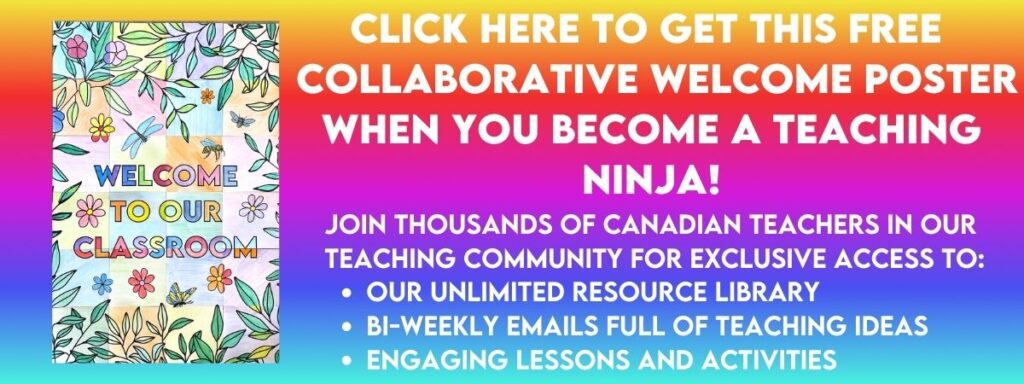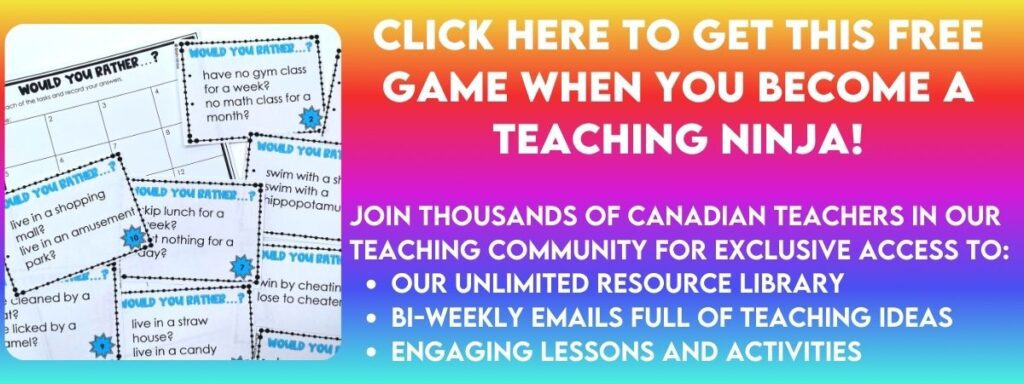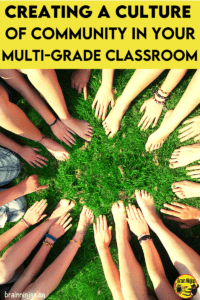
How do we create a community culture where all students feel they are equal and belong? It turns out we’ve had more combined-grade classes than straight-grade classes since we began teaching, so we can’t imagine teaching any other way. First of all, we call it a combined class rather than a split class. It’s the first thing we do with parents because our combined classes are not like the old ‘split’ classes.
When students come into our classroom on the first day of school, they immediately collect into two different groups-the lower grade and upper grade. They don’t know each other well and like to sit with their friends. We don’t give students a seating plan right away (or sometimes at all) so we can see which relationships form or are already in place, but then we slowly start changing their mindset about the combined class.
So, What Are the Secrets to Creating a Community Culture?
First of all, teaching a combined group of grade levels isn’t much different than teaching one single grade. In every classroom, there are students who are more or less mature than each other. There are students at different stages in their learning. There are students who know or do not know each other.
Yes, the expectations for your different grade levels will be different, but it’s not as different as you might think.
Use language.

Don’t call it a split class. Call it a combined class. Correct people when they use split (especially parents who grew up in a time when split classes meant students were put there because the top grade were low students and the bottom grade were high students). That’s not how students are grouped.
Students are grouped for lots of different reasons, and while academic levels can be one reason, we’ve always explained to students that they’ve become our students because they all possess unique traits and abilities that we need in our class.
Generally, parents don’t want their kids in a combined class (this is usually based on their own experiences), so your reassurance that their kids won’t miss out on anything matters.
Learn about each other.
We do all kinds of back-to-school activities that encourage us to work together as partners or groups, and we mix these groups up throughout the day and even in the middle of some of the activities.
One of our favourite activities is called Survival Island, where students have to decide which items they would want to have if they were stranded on an island. It’s actually not about the stuff at all. It’s an activity about decision-making when working in a group, and we find that doing this activity early in the year helps students learn how to agree and disagree respectfully when working together. You can find the activity in our Group Roles and Processes Unit, which you can find in our TPT Store and BN Shop.
Common traditions and classroom identifiers create community culture.
Our class chooses a theme song and motto. Collect inside jokes. Design a crest, a mascot or a special name for just your class that particular year. Your community culture should be a collective effort.
We decide on classroom agreements (rules). We allow the students to own the classroom and how it will run. When we hand over the ownership, students feel empowered as a community. All of these activities can be found in our Back to School Activities Set. Find it in our TpT Store or BN Shop. You can even try one of the activities for free. Download the Free Writing Activity from our TpT Store or BN Shop.
Do something fun together early in the year.

Within the first week of school, we do something special as a class. We’ve gone on picnics, or eaten lunch together outside. We’ve gone to the local park to do our silent reading, or we’ve learned a new game together.
Consider planning a field trip or a special dress-up day just for your class. It doesn’t have to be a big thing, but when you create common memories together, you create bonds.
Ninja Note: One year, we had a silly hair day all by ourselves. Turns out we read the school calendar wrong and had our class do silly hair day a month early, but it was a great memory. At the end of the year, every student in the class mentioned it as one of their favourite days.
If you’re looking for a list of possible special days, check out this list we made: Theme Days for School.
If you’re looking for something that takes a little less time, try this collaborative poster. We’ll send it to you for free when you sign up for our email list. You’ll also gain access to our Resource Library, where the poster is already available.
Align the curriculum outcomes on paper.
Print out your grade level outcomes side by side so you can teach the common concepts to both grades. We actually make a table with similar outcomes on the same row with Grades 4 and 5 side by side. It takes some work to copy and paste into the table, but we use this table all year long for every subject. Since the Program of Studies rarely changes, the time investment has worked out.
We wanted to share the tables we made, but that would be a copyright violation, and it would be different depending on the grades and your location.
When you teach the concepts, adjust for your learner levels. (Gee, this sounds just like differentiation in a straight-grade classroom — oh yeah, that’s what it is!) If both grades need to learn about multiplication, teach the process (which your upper grade is reviewing and your lower grade is being introduced to), then have the lower grade practice while you teach the next steps to your upper grade.
Having a specific list of the outcomes will help clarify your planning, assessments and teaching time. It also makes it much easier when checking to see what you have taught to need to teach if you add columns for each of the terms and semesters. Check them off as you go.
Encourage new relationships to build community culture.
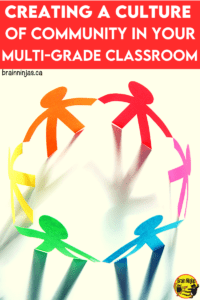
Introduce students to each other. Combine seating with different grade levels. Encourage students who don’t normally hang out together to work together.
Often in schools, students are separated by grade levels. Students rarely play with students outside of their grade level, but in a combined class, there are opportunities for students who have struggled in their own grade level groups to make new friends and leave negative relationships away.
Put students together in situations where they will get to know each other. Play games, mix up groups and create common experiences that can
Use project based learning.
Without project-based learning, we probably wouldn’t get through most of what we teach. PBL is not a project at the end of a unit. The learning happens AS the project is being done (in place of conventional learning). You can read more in The Reasons for Project Based Learning.
Teach the skill (like how to do research) and then do the project based on the grade-level content. For example, in Alberta, grade four students learn about the geography of Alberta and grade five students learn about the geography of Canada.
The whole class learns about landforms, mapping and basic geography. Grade fours do a project based on Alberta, and grade fives do a project based on Canada. When you give projects that are vigorous, engaging and open-ended, the work shifts to students-freeing you up to teach specific students or content to smaller groups.
Look for skills that align between the grade levels. These are the common things you can teach with different content topics.
Plan for the commonalities.
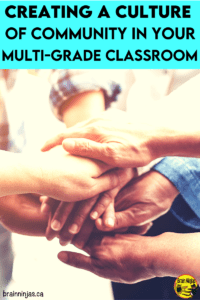
It won’t be possible to do every field trip. If you’re at a school where each grade has the traditional trips that they do each year, this will be more difficult (but not impossible).
This can work in two ways. Some of the kids might get to do the field twice (if they’re in the younger grade) or some of the older kids won’t get to do the traditional one.
Pick your battles about this. We got around a few by working with the other teachers in the grade level.
For a few, our students went with the grade level that was taking the trip, leaving behind the other grade with a substitute or by splitting them for the day. This was my least favourable option because it meant half of the class didn’t get to take part. We tried to schedule field trips in both grades on the same days, so everyone was out at the same time.
Whenever possible, use alternatives to field trips. We even asked students to help us decide which ones to do. Instead of going on an expensive science field trip that would only benefit half the class, we used the same amount of money to purchase materials that could be used to replicate the activities in our classroom for everyone.
An example is a car-building task for Grade 5 science at a local science museum. Between the cost of the program, the bus ride and the organization of parent volunteers, we were able to instead purchase car kids for everyone. We taught the specific grade level outcomes and assessed the projects by grade level, but everyone in the class got to bond over building cars, learning about electric engines and how to make a car drive the farthest based on wheel alignment.
Win win!
But what if I’m teaching online? How do I create a community culture?
Well, that does put a wrench in the plans, now, doesn’t it?
First, if you are able to be in class, please modify all the suggestions up to this point to accommodate physical distancing and hygiene practices. This might not be the right time for a secret handshake.
If you are meeting online or in person but distanced, do lots of activities to get kids chatting with each other (even if it’s virtual). We use Speech on the Spot cards as a way to start conversations in our group meetings. Instead of creating little speeches, we just use them to chat. They are great for breaking the ice. You can find Public Speaking Prompts – Speech on the Spot in our TPT Store ($USD) and BN Shop ($CAN).
Another set we use is these Back to School Discussion Cards in our TpT Store ($USD) or BN Shop ($CAN). We always use them at the beginning of the year, but they can be used anytime.
You can find these Would You Rather Cards in our Resource Library, or we can send you a set if you sign up for our email list.
We use novels all the time as a way to create a bonding experience (since the whole class is in on the book). If there is going to be too many disruptions from pandemic issues, use picture books instead. The books can follow a theme but don’t have to be exact. Read a book a day. You can record yourself and place the video within your learning management system for use online or in class for small groups.
Some of these other posts might help create community culture in your classroom:
- The Secrets to Social Emotional Learning That Will Work for Kids.
- Creating a Sense of Agency
- How to Build Relationships With Students
- Getting to Know Your Students
- How to Set the Noise Level in Your Classroom
The key to success in a combined grade classroom is COMBINATION. All ‘straight’ grade classrooms already have multiple levels and abilities. Your parents are in the grade-level mindset. Educate them and your students, and you’ll have a great year together.
What are your experiences with combined classrooms? What has worked for you? And what would you like to improve? Share your thoughts with us in the comments below.

